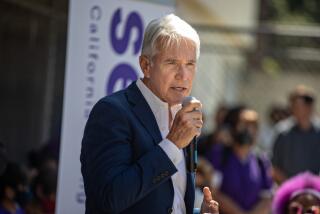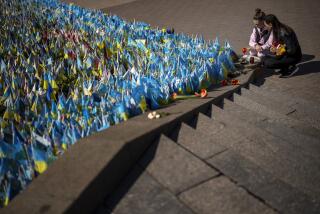Protesters Bury Him With â80 Victims : Korean Mother Again âLosesâ Son to a Cause
KWANGJU, South Korea â One month ago Thursday, Bae Eun Shim lost her eldest son in the South Korean publicâs battle for democracy when he was gravely injured by a police tear-gas grenade that struck him in the head. He died 27 days later on a hospital life-support machine without regaining consciousness.
Bae âlostâ her sonâs body to the same cause Thursday night when student leaders insisted that the site selected for his burial be changed and that he be laid to rest alongside the graves of 194 Kwangju residents who were killed in an uprising here seven years ago against the military takeover led by Chun Doo Hwan, now South Koreaâs president.
âHe is no longer only your son,â one student leader told Bae. âYour son belongs to the people now.â
Baeâs son, Lee Han Yol, 21, a sophomore at Yonsei University in Seoul, was finally buried after a marathon, 18-hour funeral that began with a three-mile march that drew an estimated 1 million people in the streets of Seoul, then traveled 170 miles south to this traditional anti-government stronghold.
Police Reclaim Downtown
Here in Leeâs hometown, seemingly all of Kwangjuâs 1 million citizens poured into the streets in mourning and protest, and authorities finally deployed riot police early today to reclaim the downtown area that had been taken over by mourners for nearly six hours.
Wearing riot helmets and gas masks and banging their riot shields, police charged into the streets here just after 1 a.m. to break up what had become a festival of defiance.
Some of Leeâs classmates and middle-class supporters were detained. Cab drivers who had been sounding their horns and backfiring their engines in protest were stopped and ticketed. âWhat are they, machines?â a businessman crouching at the corner of a building early this morning grumbled as riot police marched by in step. âThey are not even human.â
It was the kind of defiant anger shown here in May, 1980, when troops were sent into Kwangju to put down an insurrection that had begun simply as demonstrations protesting the military takeover in which Chun came to power.
Since Leeâs death last Sunday from the head injuries he suffered June 9 during a student demonstration at Yonsei University, leaders of moderate as well as radical student factions had been insisting that he be venerated as a national hero.
But his parents had resisted the idea of a public funeral. Friends and family said that in life, Lee was, at best, a reluctant radical.
Lee was a student of business administration, and fellow students noted that the June 9 protest was the first he had attended. Also, he was struck in the back of the head while running away from a police tear-gas barrage, they said, adding that radical students and protest regulars defiantly face toward such barrages, dodging the tear-gas canisters as they fall.
Moreover, several members of Leeâs family work for government institutions. They reportedly were under intense pressure from government officials to bury Lee quietly after a simple ceremony rather than yield to the studentsâ demands.
Some See Exploitation
For some, among them several of Leeâs high school classmates who gathered Thursday evening at their Kwangju alma mater for a solemn ceremony honoring Leeâs memory, there was a suspicion that the young manâs body was being exploited by opposition politicians running out of causes to help them rally their forces against the government.
âThe politicians and the radicals from Seoul are taking advantage of this,â said Seung Tae Koh, a Korean-American who attended Jin Heung High School here but who now lives in Oregon. Seung was among more than 1,000 students and alumni who gathered in the schoolâs baseball field for the ceremony, and he said that he and his contemporaries were upset about the attention Lee was getting.
âIf somebody dies, he dies. We are deeply sorry. It pains us. But they (student leaders and politicians) are just making a big political deal out of it. I resent that, and all my friends are talking about it, too,â Seung said.
Exploitation or not, Leeâs death and his image on thousands of posters stirred millions in this nation Thursday.
Applauded Along Route
After the huge funeral procession in Seoul--a cortege that some say matched the one for slain President Park Chung Hee in 1979--other multitudes turned out to watch and applaud the procession along its route into Kwangju.
Thousands of mourners traveled to remote expressway overpasses, waiting patiently for hours in a hot afternoon sun for the 200-vehicle motorcade to pass at 70 m.p.h. As it passed, complete with a truck bearing a 10-foot-high oil painting of Lee and 90 buses rented by student organizations in Seoul, the mourners waved handkerchiefs and thrust out clenched fists.
Farmers stood beside businessmen in suits and elderly country women, shouting, âDestroy the Dictatorship!â and âDestroy Chun and Roh!â Roh Tae Woo is chairman of the ruling Democratic Justice Party and its candidate to succeed Chun when he steps down next February.
Leeâs photograph was plastered everywhere along the route, in the windows of every bus and on most of the walls here in Kwangju.
As Leeâs body was taken slowly from his old high school to the plaza in front of the provincial government building in downtown Kwangju, it passed another of his photographs above the words, âWe Do Not Negotiate With Murderers. Smash the Chun Dictatorship.â
Praying, Singing in Street
Half an hour before the procession arrived at the capitolâs steps, police fired dozens of rounds of tear gas into a crowd of about 100,000 that had formed there. No one moved. Instead, they prayed, sitting cross-legged in the street and singing a traditional Korean folk song about a townsman who leaves his friends and family for an uncertain future.
Finally, just after nightfall, the procession reached the remote Kwangju Public Cemetery in the pine-forested hills 10 miles outside of town
Student leaders and Kwangjuâs largely middle-class organizers of Leeâs funeral service had selected a grave site on a hillside that has become sacred as the resting place for the Kwangju citizens killed in the 1980 uprising.
But as Leeâs body was about to be taken to that âmartyrâs graveyard,â family pallbearers shocked the organizers by carrying the coffin toward another site chosen by the cemetery supervisors.
âThe Spirits of 5-18â
âNo, no!â the students shouted. âWe want Han Yol back here. He must rest beside the spirits of 5-18 (May 18, 1980, date of the events that touched off the nine-day Kwangju uprising).â
But the pallbearers continued their solemn march to the other grave site.
âFive-eighteen, five-eighteen, five-eighteen!â the students chanted, raising clenched fists and twice forcibly stopping the progress of the pallbearers.
Finally, Leeâs mother was called down from the other grave site in tears, as she had been during most of Thursdayâs many ceremonies and prayer stops.
Accompanied by Leeâs sister and brother, the family made its last stand.
Mother Begs for Son
âGive me back my son,â Bae wailed several times, at one point pounding on her sonâs flag-draped coffin.
But the student leaders persisted and, minutes later, prevailed.
In triumph, one student climbed atop Leeâs coffin, shook his fist, rang a small bell and led the studentâs chant: âFive-eighteen, destroy the dictatorship! Five-eighteen, destroy the dictatorship!â
A Presbyterian minister said a final prayer as Leeâs coffin was placed in its final resting place beside the 1980 martyrs of Kwang-ju.
âLet us thank God for having reaped the rewards for having spilled our blood and torn our flesh,â the minister said through a crude public-address system. âAnd let us pray that the sufferings of the people are not in vain.â
But Leeâs mother did not hear the prayer. She had left the cemetery.
More to Read
Sign up for Essential California
The most important California stories and recommendations in your inbox every morning.
You may occasionally receive promotional content from the Los Angeles Times.










